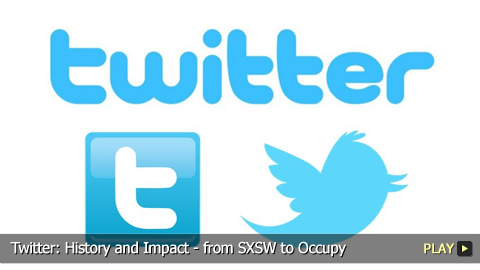Twitter: History and Impact - from SXSW to Occupy

advertisement
VOICE OVER: Rebecca Brayton
The history of Twitter dates back to 1999 when Evan Williams founded the web journal service Blogger. That company was bought by Google, and eventually Williams left to start Odeo with Noah Glass. Google employee Biz Stone quickly joined them, but soon Odeo lost focus. Star employee Jack Dorsey came up with the idea of a service that focused on status updates, and soon after Twitter was born. Events like 2007's SXSW Festival, the Olympics and the FIFA World Cup all saw explosions in Twitter use, and since that time it has become a valuable source of breaking news and an important marketing tool for celebrities. In this video, http://www.WatchMojo.com explores the meteoric rise of its company of the year for 2011: Twitter.
The History of Twitter
This web service is known for simplicity, short sentences and stupid spelling. Welcome to WatchMojo.com, and today we’ll be learning more about the history of Twitter.
Twitter Today
Today, the social networking and microblogging service Twitter gives users 140 characters with which to express themselves. These short public posts are known as “tweets,” and are displayed to followers in reverse chronological order on their Twitter main page. The word Twitter is defined as “chirps from birds” or “a short burst of inconsequential information” which conveys exactly what the service does.
Twitter’s Origins: Blogger
Twitter’s history dates back to 1999 when Evan Williams founded the web journal service Blogger. Within four years, Blogger was bought by Google, which introduced Williams to Google employee Biz Stone.
Odeo
By late 2004, Williams left Google to cofound a podcasting service with Noah Glass called Odeo, and Stone quickly joined them. However, the company failed to gain traction, so Williams turned to his staff for new ideas.
The First Tweet
Star Odeo employee Jack Dorsey suggested a service that focused on status updates. With everyone committed to that idea, Glass and developer Florian Weber helped spearhead the creation of a trial product and on March 21st, 2006, Dorsey sent the first tweet.
“twttr”
Odeo employees were the first to embrace this new service. By July, “twttr” was introduced to the public and was getting coverage in tech media. Twitter turned heads in August 2006 after news of a small earthquake in San Francisco quickly spread through the service. Within months thousands of users joined up.
The Obvious Corporation
Williams then bought out Odeo investors. He renamed the company The Obvious Corporation in October 2006, and fired Glass.
SXSW 2007
Twitter’s big splash came in March 2007 at the South by Southwest Festival in Austin, Texas; usage rose from 20 thousand to 60 thousand tweets per day thanks to strategically-placed plasma screens that streamed Twitter updates.
Personnel Changes
By April, Twitter was its own company, and one of its first investors was VC Fred Wilson. Dorsey was CEO early on, until Williams took over in October 2008, making Dorsey chairman. Following that, the company went through more leadership changes, before Dorsey finally rejoined as executive chairman in 2011 when Dick Costolo was CEO.
Twitter’s Growth
Through it all, Twitter grew exponentially: massive spikes were seen during prominent events like the FIFA World Cup and the Olympics, in addition to breaking news stories like the death of Michael Jackson or the 2011 earthquake in Japan. In cases of natural disasters, Twitter even served to reunite survivors with families and loved ones.
Twitter in 2011
In 2011, Twitter emerged as the next generation newsroom, with users sharing links and retweeting pertinent stories. Whether it was the news of Steve Jobs’ resignation or his passing, or word that the United States had finally gotten Osama bin Laden, Twitter became the preeminent way people got their news. In fact, news often broke on Twitter before mainstream websites announced it.
Protests
The service also became an integral part of sweeping social change: protesters in Tunisia, Egypt and throughout the world relied on Twitter to stoke their demonstrations. The Occupy movement subsequently used it to spread its message, as well.
Court Cases
Twitter’s coverage of prominent court cases was also significant: online users reacted fiercely when Casey Anthony was acquitted of her daughter’s murder, while a similar effect was felt after Conrad Murray was found guilty of involuntary manslaughter in the death of Michael Jackson.
Politicians
Politicians also used Twitter to varying degrees of success: while some like President Barack Obama used it to connect with constituents about issues, others like Congressman Anthony Weiner were forced to resign for misusing the service.
Celebs and Entertainment
On the more frivolous front, celebrities ranging from Shaquille O’Neal, Ashton Kutcher and Charlie Sheen used the service to communicate with legions of followers. In the process, Twitter flattened the traditional dynamics of public relations and stardom. News of Beyoncé’s pregnancy became Twitter’s biggest celebrity news story of 2011.
Twitter’s Future
By the end of 2011, Twitter boasted 300 million users. It will undoubtedly continue bringing together people of similar interests for years to come.

